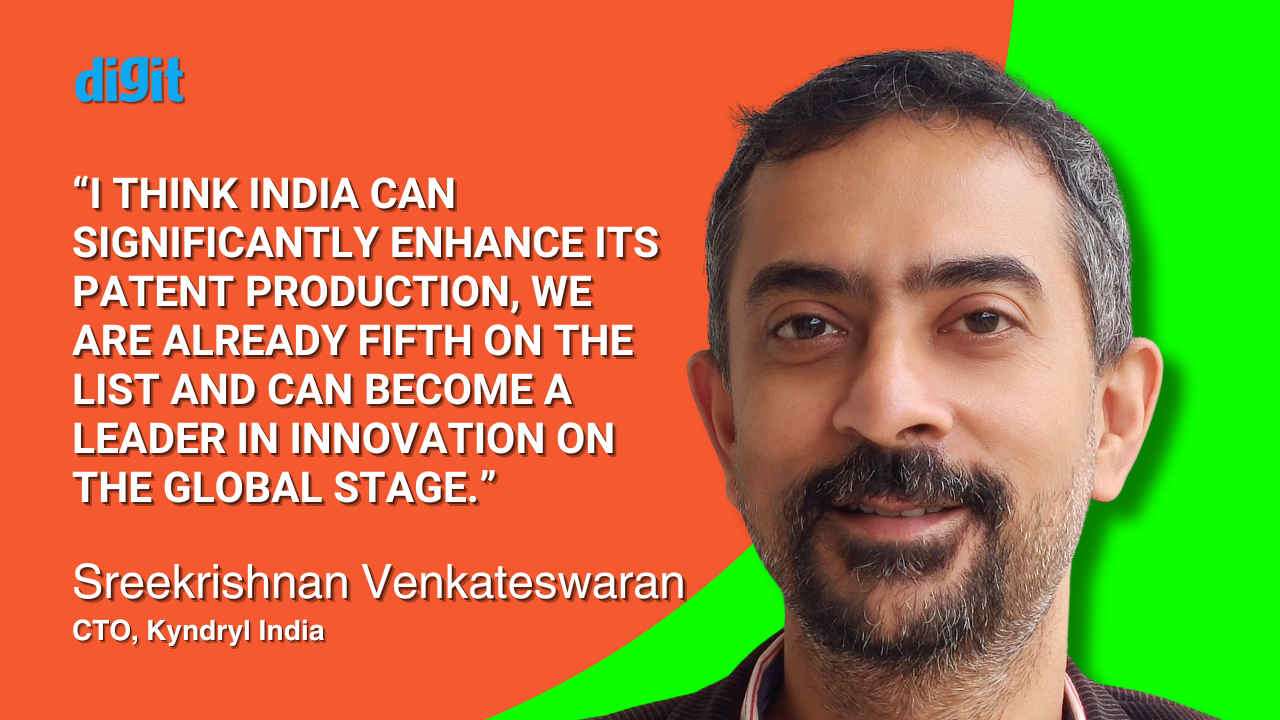Unlocking Indian tech innovation with IP and AI: Interview with Kyndryl India CTO

In the ever-evolving landscape of technology, few leaders stand out as true visionaries, capable of steering their organisations through both present challenges and future opportunities. Sreekrishnan Venkateswaran, the CTO of Kyndryl India, is one such luminary. With pivotal roles at IBM and a remarkable portfolio of 27 US patents, of which seven have been instrumental in catalysing high-value IP licensing deals with tech giants like LinkedIn, Twitter/X, and Airbnb, Sreekrishnan also chairs Kyndryl’s global patent review board on Network & Edge, a testament to his authority in shaping the company’s intellectual property landscape. With an illustrious career spanning over 25 years, Sreekrishnan’s expertise and innovative spirit are shaping the future of Indian tech innovation.
 Survey
SurveyIn an exclusive interview, Sreekrishnan delves into his professional journey, the significance of patents in fostering a culture of innovation in India, the importance of focusing on emerging tech like Generative AI, nurturing Kyndryl India’s next generation of tech leaders, and an important message for India’s future technologists. Edited excerpts from our insightful conversation follow:

Q) Tell us about your professional journey?
I joined IBM directly from the campus of IIT Kanpur, where I was pursuing my master’s in computer science and I was with IBM for 25 years, reaching the position of a distinguished engineer in 2016. When IBM spun off its technology services division into Kyndryl, I transitioned to the role of CTO Kyndryl India, and more recently I was named a Kyndryl Fellow, and additionally I served as a professor of practice in the Computer Science Department of BITS, Pilani, where I taught modern application architectures and AI.
Also read: Intel’s Santhosh Viswanathan opines on what role will AI play in India’s future
So, throughout my career I have had the privilege of working on numerous captivating projects and if I were to highlight one or two, maybe one from my early days and one more recent: In the early 2000s, I led the embedded firmware development for a lifesaving medical device for IBM’s clients. And notably, we created the world’s first wireless pacemaker programmer and an innovative device that revolutionised lung biopsies, making the procedure easier, safer and painless. It’s fulfilling when you see technology you have developed widely adopted, especially in healthcare. Recently I spotted one of these pacemaker programmers on a doctor’s desk at a local hospital here in Bangalore, and this was a vivid reminder of the meaningful impact of our work.
Now taking a more recent example, as CTO for Kyndryl India, I’m leading the implementation of a transformative digital platform for a major Indian fintech, and this platform has significantly enhanced financial inclusion by enabling secure, scalable, accessible digital transactions for millions of users across India over the last 2.5 years. These experiences overall have shaped my journey and career trajectory, and they’ve also underscored the profound impact that technology can have on society when harnessed effectively and ethically.
Q) How would you look at your inventions over the years?
To illustrate how some of these patents have tangibly improved people’s lives, I’ll take you back to the year 1999. At that time, I was leading a cutting-edge project at IBM to develop a smartwatch. The challenge here was to miniaturise an operating system designed for servers and adapt it to function effectively on a tiny wristwatch. This required us to innovate extensively, addressing numerous technical challenges ranging from power consumption to memory constraints to user interface design, and so on. This was 25 years ago.
Our successful implementation of this project not only resulted in multiple US patents but also laid the groundwork for the pervasive computing industry, influencing its development over the next two decades. These patents that I referred to were subsequently cross licensed by IBM to other companies, enabling further innovation and advancement in wearable technology. For this pioneering work, we recently won the Test of Time award from the Association for Computing Machinery (ACM). This is a recognition of work that has had a sustained impact in the community over many years, a decade or two decades.
Another notable example involves a set of patents related to computer networks. IBM licensed these patents to companies like LinkedIn and Twitter, perhaps contributing to the robustness and efficiency of social networking platforms that millions of Indian and global users use daily. I believe these examples highlight how our back-end technology, initially developed for specific projects, can have a broad and lasting impact.

Q) What is the stumbling block for tech innovation in India?
I’ll start by acknowledging that India has made significant strides in very recent years. The number of patent applications and patents granted, I think, crossed the six-digit mark – 100,000 patents – the previous financial year, which is like a threefold improvement over the previous years. But that said, there is still so much to be done to truly excel in this area and catch up with the leaders in the US and China. In my mind, there are a few steps that India needs to take:
One is to emphasise quality over quantity. India must focus on the quality of inventions in addition to the number, and this can be achieved through education at the grassroots level. We need to encourage innovation where it often happens unnoticed. By fostering this culture of creativity and critical thinking from an early age, we can nurture a generation of innovators.
The second is India needs to streamline its patent evaluation process. We need to increase the manpower dedicated to evaluating patent applications. That is crucial to reduce the time taken to review and approve these applications. Currently, the time required to process patent applications in India is still longer than in the US or China. Also, regular training for patent examiners is essential so that they can stay updated with evolving technical knowledge and become SMEs themselves.
The third would be investments in R&D for emerging technologies. India needs to step up its investment in research and development, particularly in sunrise technologies, because these are the technologies that will help India consistently maintain a double-digit growth rate for the next 25 years. These investments should be genuine, focused on creating meaningful advancements, not merely for marketing purposes.
And finally, I think we need mature intellectual property recognition. India must become a mature nation in recognizing and enforcing intellectual property rights. This means accelerating the recognition and enforcement of patents to align with global standards. Quick and fair enforcement will encourage more innovators to file patents domestically.
So, addressing these few areas, I think India can significantly enhance its patent production. We are already number 5 on the list and can become a leader in innovation on the global stage.
Q) So the problem isn’t one of lack of talent?
That’s right. A lot of the innovation in our experience happens at an early stage of any project and at that stage, these innovative ideas often go unnoticed. So, if we nurture that critical thinking at an early stage, then we can create a generation of inventors. We do have the skills, the manpower, and even the data in this country. But there are some nuances that we need to address here to cross the line.
Q) As a master inventor, how are you enabling the next generation of Indian innovators at Kyndryl India?
Clients expect Kyndryl to innovate quickly, and my team has consistently risen to this challenge with several impactful projects delivered from India. For a major telecom company, we rolled out a highly automated edge cloud that hosts critical distributed business applications. In the microfinancing sector, our technology is enabling institutions to drive economic change in rural areas. With healthcare providers like diagnostic companies and hospital chains, we are digitising operations to improve patient care. At an airport, we are infusing technology into various facets that enhance passenger experience and operational efficiency. For an automotive company, our solutions are powering connected vehicles, paving the way for smarter driving. We run mission-critical applications for a large bank, engineering high availability in the face of colossal user load. We even helped a gaming company launch their first product in India. We recently worked on a project of national importance that addresses the challenges of financial inclusion within the economy. Also, in the Edtech sector for an edtech client, we are developing a massively scalable learning platform leveraging hyperscalers, modern databases and generative AI to revolutionise education access and quality. So, you see across many verticals, we are doing deep work and this would exemplify our commitment to innovation. You know, each project also involved multidisciplinary teams working together, harnessing our collective knowledge and driving meaningful outcomes.
Also read: Amazon’s Rajeev Rastogi on the impact of Artificial Intelligence on E-commerce in India
Also the Kyndryl Fellows program is designed to nurture future leaders by recognising and fostering top talent within the organisation. Kyndryl Fellows serve as mentors to emergent leaders, and this mentorship helps to cultivate technical leadership skills in the next generation within the company. Kyndryl Fellows are encouraged to work across teams, projects, geos and practices, fostering a culture of collaboration and innovation, and this exposure helps future leaders gain a broader perspective as well as a deeper understanding of the business. In terms of innovation and research, most Fellows are involved in cutting-edge research and development projects and that allows them to contribute to and lead innovative initiatives. And this environment promotes creative problem-solving and leadership in technology and tech innovation.

Q) What emerging technologies should India focus on over the next 5-to-10 years?
The year 2023 marked a watershed moment for technology in more ways than one. We witnessed the resurgence of AI. Thanks to the proliferation of generative AI technologies, we saw new and more powerful models arriving every few weeks, impacting many spheres of life, many facets of business. In the next year, these mighty models that generate everything from text and code to voice, video, and images, will continue their march. The good news is that based on what we are seeing so far, Generative AI will not create an oligopoly where only a few have the resources and expertise to build, train, and operate large and specialised models that the rest of the world has to use. There are many players already in this field.
The past year also saw open-source large language models or LLMs taking birth. Several of them were championed by large enterprises, and the next few years are poised to see more action, but predicting whether open source can emerge as the winner is perhaps best deferred by a year. The societal impact of all this generative AI and its interplay with the law will become captivating in the near future. It will cover intellectual property, liability, indemnification, privacy, security, responsibility, and bias because these models are trained on huge corpuses, which is the worldwide web. They’re trained with the entire Internet, and the internet has bias due to existing historical bias. The internet has copyrighted material, and all of this gets ingested not as raw data, right? The way the neurons are interconnected, you can’t really control the data by controlling the neurons. It works in a different way, so all of these aspects that I’ve mentioned – the law, privacy, security, bias, responsibility – are going to come centre stage in the next few years.
Researchers talk about artificial general intelligence called AGI, which is general-purpose AI or superintelligence, so to speak. That is a real possibility over the next few years, and that can be a game-changer in so many ways. Now, how would people have reacted just a few years back if we told them they would have a language understanding system to which they can ask any question and they would get an intelligent response? They would not have believed it, and that is a statement on what will be achieved in the next few years. So, I think these are the areas which would propel our growth. As for India, we have plenty of skills, manpower, data; we have all the fuel needed. We just have to leverage all of this, and then grow and become the best.
Q) What’s the Indian government’s incentive in protecting IP and fostering tech innovation?
The Indian Government has a 25-year roadmap, right? India in 2047, 100 years of independence, and we want to be as close as possible to being the biggest economy in the world. To grow, we need to sustain a double-digit growth rate for many years, so 10% over the next 25 years. In order to achieve this, it’s clear that we have to invest in sunrise technologies, right? Exponential technologies as they are called, not only in the traditional technologies like textiles and manufacturing. It has to be the new tech: AI, data, Generative AI, blockchain, metaverse, and whatnot. When we talk about this, IP protection becomes key, because intellectual property is the big fuel. In order for us to climb the scale in terms of size of economy, there is a correlation between that and the amount of IP friendliness that our country has. When I say IP, it is also publishing more papers in conferences and journals and producing more PhDs and so on. So, we’ll have to catch up with the leaders in all these fields.
Q) Any message for India’s young tech innovators?
I would say that to have a great career in technology, you have to fall in love with the field. As you progress from early-stage career to mid-career, shift your focus from depth of experience to breadth of perspective. In the early years, focus on gaining depth in multiple domains. Be a bit of a rolling stone and gradually acquire breadth. I think that is key. Throughout a long career spanning 35-40 years, you will encounter tech disruptions and discontinuities. That is a given, but foundational skills such as algorithms, mathematics, and statistics will endure, and they will keep you ready for opportunities over the long term. Finally, mastering the art of multitasking without feeling overwhelmed can be immensely rewarding as well.
Also read: MediaTek India’s Anku Jain explains the impact of AI across different sectors in India
Jayesh Shinde
Executive Editor at Digit. Technology journalist since Jan 2008, with stints at Indiatimes.com and PCWorld.in. Enthusiastic dad, reluctant traveler, weekend gamer, LOTR nerd, pseudo bon vivant. View Full Profile